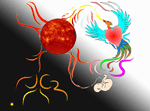« Umuntu ngumuntu ngabantu »
« A human being is a human being through other human beings. »
|
From origins to man,
the development of the moral sense.
2 - The moral sense in the course of evolution :
The time has passed when animals were considered "amoral", i.e. alien to morality, and when only instinct and other automatisms guided their actions. Primatologists were the first to recognise that our 'cousins' the monkeys also possessed a moral sense.A - Approaches to moral behaviour in humans and primates :
a - Approaches to human morality :Morality is generally considered to be a product of reason and logic. Being aware of the necessities of living in society, humans have developed laws to regulate interactions : these laws impose norms, such as cooperation, fairness, etc. They are intended to protect social order because, in human nature, there are many deviations that generate conflict. If necessary, the rule can be imposed by force.
Two origins are attributed to these moral laws.
- At the level of tribes or states, it is the chief and his advisors who draw up the rules ; in the case of religions, it is God who lays down the rules. In this case, morality is considered to come from above.
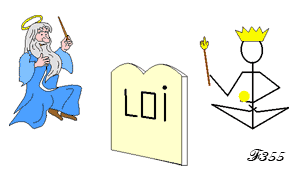
- Another approach, based on psychology, neuroscience and biology, considers that the moral sense is rooted in the individual and his or her capacity to feel good and evil.
It is not society and its behavioural inconsistencies that tell the ruler what rules to adopt, but the ruler's innate sensibility that indicates what to do, and it is thanks to their innate sensibility that their constituents perceive the validity of these rules. In this case, morality is considered to be constructed from the bottom up.

In the first case, the rule established may be just and approved by all, but it may also be unjust and imposed by terror. In the second case, on the contrary, it is initiated by behaviours, even feelings that have matured over the millennia before being inscribed in the genes and then in the laws.
If the moral sense of man is well enough known to have been studied for centuries, what do we know about it in animals ? Some animals seem to have precursor elements. But can we talk about morality in this case ? The question remains.
b – Questions concerning animals :
Today, scientists consider that the use of force is no longer the only one to govern animal behaviour : on the contrary, many acts of tolerance, conciliation and sharing can be observed, particularly in primates. For example, in macaques, members of a group show more patience towards a disabled individual.
Is it possible to speak of the beginnings of a moral sense ?
Not all ethologists agree on this. However, some researchers, such as the primatologist Frans de Waal, believe that some monkeys understand the needs of others and may sacrifice their individual interests for the benefit of the community: a sign of both empathy and altruism. These animals would therefore possess a certain moral sense.
However, can we really be sure that they feel the distress of other members of their community ?
There are two hypotheses:
- According to the first, they simply react to the actions and distress signals of their fellow creatures without any conscious intention of providing help.
- According to the second, these animals perceive the emotions and needs of their fellow creatures and respond to them. Thus, great apes, unlike other primates, would be capable of attributing a mental state to others, which would explain why they console those who have been attacked.
c – Interpretations given to the notion of morality :
While not all researchers agree that animals have a moral capacity, their disagreement stems from the definition given to morality. According to the French sociologist Émile Durkheim (1858-1917), a moral system is based on a set of norms established by the members of society. This view implies that the rule appears only with rational thought, which applies only to man. His emotional sensitivity is not taken into account. |
 |

However, in the course of evolution, it turns out that the opposite has occurred : it is only after the emotional response that rational thought comes to codify, through rules, innate behaviour, in order to organise life in a community.

To assert that morality is based on established norms is to ignore sensitivity and the resulting capacity for empathy, which appeared long before language.
It is also considered that no animal has as developed a sense of justice as humans. This is illustrated by the « ultimatum game », in which an individual is given a certain reward (food in the case of animals), which he must divide between a partner and himself as he sees fit. If the partner accepts, the rewards are distributed according to the distribution determined by the leader. If he refuses, no one gets a reward.
In such a situation, humans consider offers of less than 20 per cent of the total to be unfair, and they refuse them, thus depriving the stingy giver of his reward. For them, unfair sharing must be punished.

In contrast, chimpanzees and bonobos accept all offers, even if they are unbalanced. If they seem to be more rational from a strictly economic point of view, it is because they would not have the social norms that lead them to consider that the behaviour of the other is unjust. For this reason, many ethologists consider that the concept of morality is alien to animals and therefore does not allow us to understand their actions.
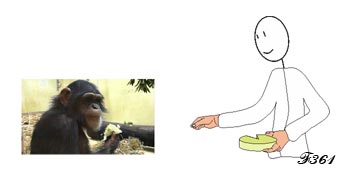
What is really going on ?
We can see that if the monkey accepts according to its needs (that of food), man may not accept an unfair share when money comes into play. Would he react in the same way if it were food?
We could therefore consider that if the monkey accepts according to real needs, man punishes the one who does not satisfy the needs he creates for himself.
Similarly, if stealing is one of the forbidden things in man, perhaps this is a consequence of his tendency to appropriate goods that are often useless to him.
Theft is not a problem for the chimpanzee, unless the thing stolen is necessary for him. If it does have a 'moral sense', it is not at the level of the good it possesses, but at the level of the good it needs : its sense of fairness provides for this, complemented by its natural tendency to cooperate.
The morality instituted by human societies thus appears in the form of rules where equality is instituted both as a moral right and as an obligation. Yet morality could be examined differently, by simply seeing the gift given by the other, and feeling the pleasure derived from it.
So do animals have a moral code ? We cannot determine this. We will only observe the development of this sense by tracing the evolution of behaviour within animal species.
B – Emotions, cooperation and empathy in the animal world :
Until now, we have never talked about emotional reactions in animals. However, anyone who has owned a dog has experienced its ability to feel its owner's emotions and to express its own needs.Other animals are not to be outdone, and a growing body of scientific research is revealing their capacity for empathy, which is on a par with that of humans. A means of communication between species that allows us to recognise the intentions of others, this mechanism first appeared in the animal kingdom. It has been progressively perfected to reach its peak in the most advanced mammals : in the latter, it has also become a capacity for adaptation to social life.
a - Primates :
As we have seen previously [cf : feeling what the other feels - in french], the motor neurons in the prefrontal cortex of a monkey that are activated when it prepares to make a movement are activated in the same way when the monkey watches another monkey or a human being perform the same gesture. The perception of movement is thus evoked in this mechanism.
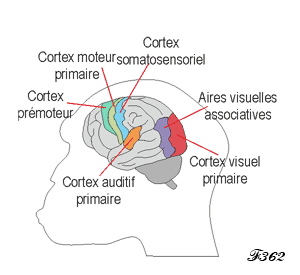 |
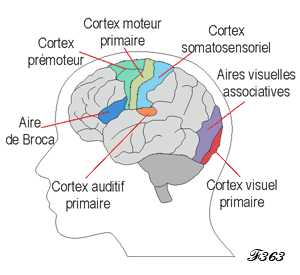 |
However, while the frontal cortex is a key area for empathy, further studies now suggest that other brain regions may function as mirror neurons.
This is the case for certain neurons in the insula and anterior cingulate cortex, which show responses normally linked to the affective component of pain. The sensation then occurs in addition to the perceived movement.
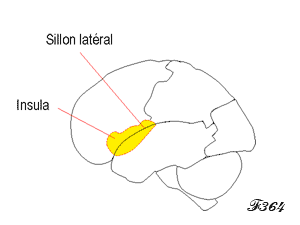 |
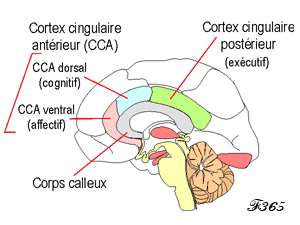 |
Indeed, when we respond to someone's emotion and come to understand their experience, this presupposes the existence of important cognitive capacities of our own. But the emotional connection occurred long before representation and understanding, and in this area animals, even those far removed from man, have nothing to envy him.
For example, experiments in other mammals suggest that the emotional component of this process was already at work.
We have already learned that children have an innate moral sense : could this be found in other species ?
1 - Great apes - chimpanzees, gorillas, bonobos :
- Altruism :
What can we say about the great apes ? Today, we recognise their ability to communicate through language, even if it is far from being as sophisticated as that of humans. Their intelligence allows them to make and handle tools, and their memory, similar to that of humans, often exceeds it.
What then could be the specificity of man, despite the fact that he is self-proclaimed as the "culmination of evolution" ? Philosophers and biologists answer: "His moral sense!"
Les animaux en seraient-ils dépourvus ?
However, gestures of « consolation » are regularly observed between great apes, as well as scenes of sharing and mutual aid.
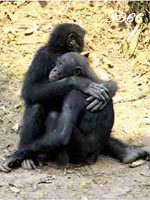 |
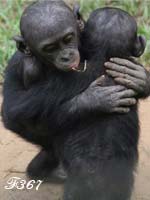 |
These gestures show their ability to perceive the needs of others.
This comfort, given to the victim, does not always lead to personal benefit. According to the British primatologist Zanna Clay, it is more frequent within the same family and among young people.
The same behaviour has been observed in gorillas at the Atlanta Zoo.
However, researchers are still divided on the meaning of these gestures : is it a genuine feeling of compassion, a hope of reciprocity, or a purely instinctive and automatic behaviour ?
The primatologist Frans de Waal has observed similar behaviour in chimpanzees : after an argument between two chimpanzees, a third chimpanzee who has witnessed the scene approaches the loser and hugs him, as if to console him.
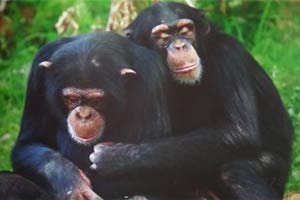
Many primatologists interpret these behaviours as empathy and altruism. For them, the roots of the moral sense did not appear with humans, but go much further back in our genealogical origins. They can be found in the different branches of our common tree.
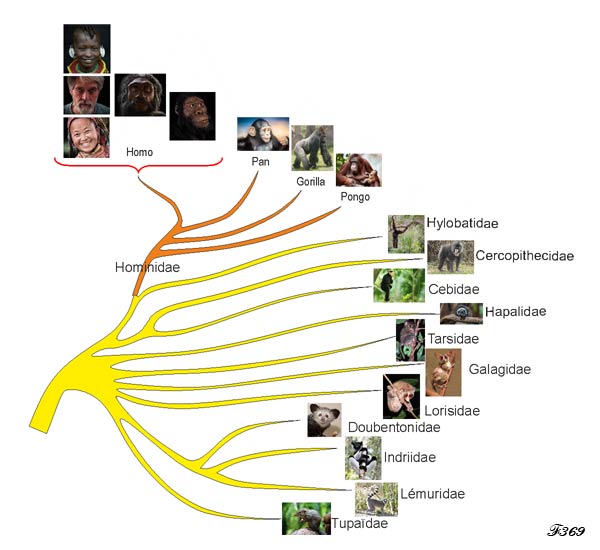
Phylogenetic tree of primates.
Unfortunately, this point of view is difficult to demonstrate because, unlike what can be done with humans, experiments on captive subjects involve many biases : how can behaviours be observed in nature that undoubtedly cost the actor and benefit the receiver ?
- Sharing :
For example, Dr Brian Hare of Duke University observed that the bonobo, a cousin of the chimpanzee, when placed in a cage with food, prefers to share its food with a fellow chimpanzee whose door it will open in the next cage.
Similar behaviour has been observed in an orangutan at the Phoenix Zoo in the city of Miyazaki, Japan. For some years now, it has been sharing its food with chimpanzees in a neighbouring cage.
However, this gesture raises questions when it occurs in captivity.
More interesting is the research carried out by American anthropologists David Watts and John Mitani, who have been studying chimpanzees in Kibale National Park in Uganda for more than twenty years. During this time they have witnessed a recurring sharing scene : after hunting together for colobus bai , a small monkey that is sometimes on their menu, one of the primates takes the prey, and the others beg for a share by holding out their arms. Even the dominant male will beg for his share.
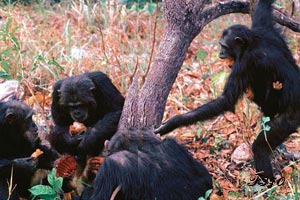
While three chimpanzees are skinning the bay colobus they have just killed, a female comes to beg for a share.
The owner of the prey must distribute it himself, but he can also be content to let his fellow chimpanzees help themselves.
Thus, after participating in the hunt, apes willingly share the fruits of their cooperation, even between different clans, showing their sensitivity to equity.
This is especially true since the one who shares does not act as the dominant one who helps himself first : the sharing takes place within minutes of obtaining the meat. He therefore takes into account the needs of his companions.
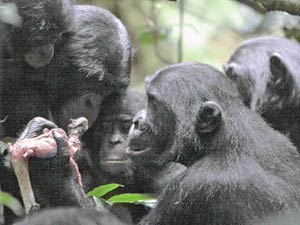
After removing the head of a cephalophe,
a female shares pieces of meat with her offspring and adult females.
a female shares pieces of meat with her offspring and adult females.
"Getting this food takes effort, and chimpanzees obviously don't give it away to just anyone," says John Mitani.
Simple sharing can also turn into a trade-off. Meat can thus be exchanged for sex with females, or precede delousing sessions, as has been observed in the Taï National Park in Côte d'Ivoire.
For the American primatologist Sarah Brosnan, there can be no cooperation without a fair distribution of the fruits of labour. When two chimpanzees hunt together, if one of them is disadvantaged, it is likely to ally itself with another partner. This suggests that chimpanzees, like us, are sensitive to inequity, which is one of the components of moral sense.
In 2003, Sarah Brosnan was able to verify this behaviour in capuchins : the latter had to give a token to the experimenter to obtain food. Depending on the colour of the token, the capuchin and its cage neighbour were given the same reward or not. The result : the monkeys refused pieces of cucumber if their neighbours got much better grapes.
However, the demonstration of the expectation of reciprocity is not convincing for all researchers, as there may be flaws in the experiments.
In fact, in their natural environment, animals choose their partners, whereas in the laboratory they are forced upon them, explains Sarah Brosnan. Furthermore, the tests only last thirty to sixty minutes, whereas in the forest, relationships are formed over long periods. This may explain the discrepancies between the field and laboratory data.
On the other hand, when studying animal behaviour, humans use their own logic and base their deductions on their knowledge. In order to understand animal empathy, perhaps it would be useful to base his deductions on his own capacity for empathy ? But in this case, he would come up against the subjective aspect of his sensitivity.
See you again.
Adoption :
Other behaviours raise questions. Over the past thirty years, in the Taï park in Côte d'Ivoire, primatologist Christophe Boesch has observed the adoption of a dozen orphans by males, which goes against what we know about their behaviour.
But is this altruism or an innate behaviour that preserves group cohesion ?
Altruism :
Experiments conducted in the laboratory of Kyoto University have made it possible to answer this question. Two chimpanzees were placed in rooms separated by glass and could only communicate through a tiny window. One of them, after completing a task, was entitled to a glass of orange juice but, to catch it, he needed an object available to his fellow chimpanzee in the next room : either a cane if the glass was far away, or a straw if the glass was close. The latter had to understand the situation and choose the right object from the seven available..
Primatologist Shinya Yamamoto and his colleagues found that, more often than not, the chimpanzees tested gave their neighbour the right tool.
In another experiment, the researchers made the separating glass opaque. They found that while the monkeys continued to give priority to cane and straw, having understood what was expected of them, they gave either one or the other.
In the first experiment, the monkeys had therefore understood their partner's needs and felt the desire to satisfy them, which would reinforce the hypothesis of altruism.
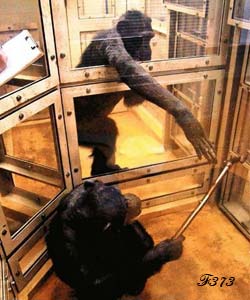
Chimpanzees can help each other and provide the necessary tool for their mate (here a walking stick).
Altruism with strangers :
This altruism can even be found towards other species: in an experiment conducted in 2013 by the American anthropologist Brian Hare and his Chinese student Jingzhi Tan, bonobos from the Lola Ya Bonobo reserve (in the Democratic Republic of Congo) had to choose between feeding one of their own or an ape from another species.
A first set-up consisted of 3 cages arranged side by side and separated by doors. In the middle cage, pineapple and banana slices were placed. The bonobo entering this cage could then choose to open the doors separating it from its two neighbours : a bonobo it knew well and a stranger.
It was found that although the bonobo generally opened the door to its two neighbours, the first door it opened was often that of the unfamiliar primate.
In another set-up where there were only two cages and one neighbour, the bonobo opened the door more easily to the stranger. Then, once they were together, the primates often had sexual relations.
To understand their motivations, a third device was put in place, prohibiting all physical contact. This time, the apes were separated by a cage where food was kept. The bonobo tested could allow its partner access to the food by opening the cage door with a rope.
Two cases were then presented:
- If the bonobo could not access the food, it opened its neighbour's cage with the rope.
- If the bonobo could access the food, it would eat without worrying about its neighbour.
Thus, the bonobo is much more altruistic if it can physically meet its neighbour.
How does this moral code develop over the course of evolution ?
2 - The little monkeys :
This tendency to share is coupled with a natural aversion to iniquity.
Primatologists have observed that if a capuchin monkey receives a reward for a similar task that is of lesser value than the one given to one of its fellow monkeys, it becomes aggressive and prefers to refuse the reward.
The feeling of injustice in the capuchin.
Can we deduce from all these examples that primates have a moral sense?
It is true that primates, like all social animals, are concerned with the relationships between individuals within the group : sharing resources, reconciliation, respect for hierarchy, etc.
However, if their individual behaviour meets the criteria of morality, they seem to lack another level, specific to the human species: concern for the community. It is this element that would lead humans to be concerned with harmony and cooperation within the group, which would justify the rules of conduct.
However, closer examination shows that, within a small group where all members know each other, humans and apes have the same concern for community.
The role of the alpha male and community concern.
In humans, large groups whose members are too numerous or too far apart and have difficulty getting to know each other must be structured by laws that are often coercive, otherwise clashes will occur. Poultry farmers are well aware of the problem : raised in small groups and outdoors, peace is the rule, but hens kept in cages of 18 per m2 do not escape conflits. Cutting off the animal's beak seems to provide an answer.
Similarly, as we have seen, distance reduces the sensitivity required for moral acts.
All species have the ability to perceive danger. Evolution has perfected this sense in social mammals by giving them the ability to sense the needs of others : empathy. This ability, which is revealed as soon as the family is established, makes it possible to provide parental care even before developing relationships within the group.
In the absence of rivalry, this capacity even promotes relations between groups and even between different species.
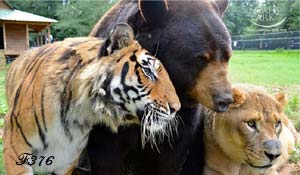
Thus, if humans can help animals, the reciprocal also exists.
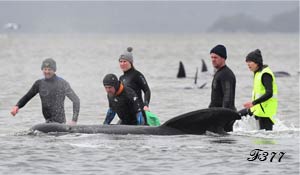
However, just like humans, animals that have been harmed will be reluctant to help : individual protection then takes precedence.
However, some experts are still sceptical about the fact that animals can experience complex emotions and have social responsibilities. Professor Frans de Waal, for his part, believes that animals do not have a developed and reasoned sense of right and wrong like humans do. For him, the difference comes from the fact that human morality is not based on individual experience as in animals : it comes from the set of ideas and feelings specific to man.
In fact, although the moral sense of both animals and humans is based on the same emotional foundations, humans do not have the same moral sense as other animals : the latter do not have the written rules that guide (but can also freeze) human behaviour.
The collective behaviours of animals respond to the rules of a group inserted in its environment.
Human thought, on the other hand, can freeze its knowledge in all fields, including that of morality. Thus, in the field of religion, morality, even when taught by an all-powerful God who is the shepherd of his people, will find it difficult to impose itself.
Why such inconsistencies ?
We can see that while man has a reasoned sense of right and wrong, he has largely lost the sensitive perception of what is good or bad for him and for the world in which he lives.
He knows what is good and what is bad, but, as with criminals, he no longer feels it in his body and heart, which prevents him from conforming to it.
He knows the rules that should condition his behaviour, but he no longer has the moral 'feeling', the only inner strength that allows him to resist the impulses.
If he felt love, he would immediately feel the aversion to kill and would follow the teachings of his god who nevertheless encourages him to love his neighbour and respect his creation. Man, if he has suffered too much and blames the other for his suffering, often acts in contradiction with the collective rules.
What do we really feel when we experience this moral sense? A sense of well-being accompanied by a feeling of inner fulfilment. Empathy adds to this the pleasure of the encounter, to which is added a deep feeling of communion with the other, whoever he or she may be.
As for the world around us, it is a source of boundless wonder.
This feeling existed long before speech and reasoning, and it surpasses all discursive reasoning about the world... Could animals lack it ?
«To be capable of empathy is to be able to feel what the other person feels,
whether they are human or animal. »
whether they are human or animal. »
b - More distant animal species :
Until the last century, humans were the only species deemed capable of experiencing complex emotions. Today, knowledge of other species has been refined to the point of recognising their ability to distinguish between what is "good" and what is "bad".
Could "good morals" be embedded in the brains of all mammals, just like instinct ?
Wolves :
If chimpanzees show their sense of justice by attacking those in the group who transgress the codes of good behaviour, dominant wolves also show a certain sense of fairness : they sometimes swap roles with wolves of lower rank, showing their submission and even allowing them to bite them.
Dogs :
However, while we can observe the behaviour of wolves within the pack, it is difficult to determine whether their actions are consistent with what we call moral sense. Dogs, being closer to humans, may be confronted with situations in which the human moral sense is at stake. Can the dog react according to this feeling ?
A study conducted by researchers in Kyoto (Japan) and published in the journal Neuroscience & Biobehavioral Reviews tends to show that dogs express more restraint towards humans who are less respectful of their fellow man. In this study, the dog is put in the presence of its master and two strangers. While the owner tries to open a box, one of the strangers offers to help while the other refuses. When the strangers offered the dog a treat, the dog was more likely to accept the treat offered by the helper.
Psychologists at Kyoto University concluded that dogs are able to discern good from bad in the actions of members of another species.
Similar behaviour was observed in another situation where dogs show a preference for generous attitudes, for example when a stranger gives money to a homeless person.
This suggests that dogs are able to make social judgements, similar to those made by children at an early age. This may well be an indication that the basis of morality is innate, as it is acquired very early in the evolution of the species.
Can all these bonds that are established between members of the same family, of the same species, but also between different species, include the mourning that ethologists have observed many times ?
In primates, females carry their dead. Elephants return to the scene of a death. Cetaceans keep their young on the surface. When it spots a dead fellow human being, the crow calls out to others, and they all gather around the corpse and participate with their own calls.
Although we do not yet dare to speak of a moral sense, we can nevertheless imagine that at a certain stage of evolution, the inner experience of being connected to the other can be interpreted as an emotion comparable to that experienced by humans. Moreover, in all mammals, isn't this emotion under the influence of hormones ?
Mice :
Another study has shown that when two mice are subjected to the same pain, the one subjected to it second twitches more if it has seen its neighbour do so. This mimicry is only observed between mice that know each other. Moreover, male mice are less sensitive to pain when they see a foreign male suffering, as Dale Langford, a psychologist at McGill University (Canada), has found.
These results are reminiscent of another study conducted in humans in 2006 by psychologist Tania Singer of the Max Planck Institute in Leipzig. The suffering of others activates the pain regions of the brain in humans, if the victim and bystander have cooperated beforehand.

The suffering of a friend is experienced in the same way.
However, if the bystander has previously been treated unfairly, it is the pleasure centres that are activated at the sight of the pain experienced by the abuser.

The suffering of an enemy is experienced as a pleasure.
In mice, although there is no certainty that they experience emotions identical to those of humans, it is accepted that this phenomenon involves mirror neurons.
Rats :
In the course of research on rats, the barrier to the abilities they were thought to have is being pushed back again and again.
Nobuya Sato and his colleagues at Kwansei Gakuin University (Japan) studied Sprague-Dawley rats, which are docile and easy to handle, to see whether their social skills included the ability to help others without benefiting from it.
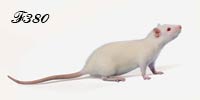
Rat Sprague Dawley.
In a transparent container with two compartments - one filled with water and one empty - the scientists placed two rodents, one in each compartment. The rat in the water could drown if its mate did not help it. The rat in the dry could save him if he opened a door in the partition, which would allow him to leave his pool.
To do this, the rat in the dry compartment had to find out how to use the latch to open the door, before helping his mate.
The researchers found that the animal almost always came to the aid of its companion and that, as the trials progressed, it took less and less time to open the door. Moreover, if it rushed to help its companion, it only did so if the latter was really in danger.
Finally, when the researchers reversed the roles and the rat in difficulty took the place of the rescuer, it rushed to its companion's aid much more quickly. So, is this an innate reflex behaviour or empathy ? It was difficult to come to a clear-cut opinion.
To find out, the researchers confronted the rescuer rat with a dilemma : to choose between a chocolate reward and the rescue of its fellow rat plunged into a deeper pool than previously.
To do this, they trained five rats (batch 1) to open the door to rescue their companion in difficulty, and five others (batch 2) to open a door to a compartment where chocolate cereal was stored.
The pairs were then tested in a three-compartment box with an empty compartment (where the trained rats were successively placed) surrounded by a compartment with water and one with cereal.
The rats in the first batch opened the door to release their mate much more quickly than the rats in the second batch. Less than half of the rats in the second batch rescued their mate, but this proportion was higher than that of the rats that preferred the reward in the first batch. Learning was therefore not the determining factor in their behaviour : not only do rodents seem to consider the life of another more important than food, but 25% of them even shared the reward obtained.
Cetaceans :
As is the case with humans, the brains of dolphins and whales have mirror cells, which cause them to perceive the needs of other species. "We have seen dolphins helping humans to escape from sharks, or elephants helping antelopes to escape from enclosures.
According to Professor Marc Bekoff, despite the belief that only humans have morals, the evidence is mounting that this is not the case.
Birds :
1 VIDEO MP4 centrée :
Reanimation.
1 VIDEO MP4 centrée :
Crossing the road.
c - Insects :
With a volume of 1.5 mm³, the brain of the rat seems quite capable, under survival conditions, of competing with the 1130 cm³ of the human brain. What about the 0.5 mm³ of the ant's brain, the 0.3 mm³ of the fly's brain or the 1 mm³ of the bee's brain ? Despite their small size, could insect brains also surprise us ?
Ants :
At an early stage of evolution (over 100 million years ago), ants also revealed their intelligence.
This intelligence is being studied (both individually and collectively) by Antoine Wystrach and Audrey Dussutour, two ethologists from the Centre de Recherches sur la cognition animale (Animal Cognition Research Centre) at Paul Sabatier University in Toulouse.
These researchers have shown that a collective intelligence capable of managing all the interactions between individuals and their environment emerges from a colony composed of several thousand individuals. For example, it is collectively that ants use simple rules to adapt their movements to the constraints of the environment, thus avoiding traffic jams.

Creating tracks.
Antoine Wystrach and his colleagues also conducted experiments on ants of the species Cataglyphis velox living in the Andalusian desert : they found that after travelling a certain distance, an ant can drop its load, turn around, observe its environment by aligning its body in the direction of the road and then resume its journey in the right direction. With a brain of only 100,000 neurons, these insects know perfectly well how to use environmental cues to avoid getting lost.
In Scotland, zoologist George McGavin and biologist Adam Hart are also studying the behaviour of ants and trying to understand their organisation.
In fact, despite their numbers and an intelligence that seems limited by the size of their brains, ants move and act with astonishing coordination. Moreover, they show an impressive cooperative and altruistic functioning.
Their communal functioning has enabled them to adapt to almost any territory thanks to their ability to work together in fields as diverse as gathering, farming, hunting and breeding.
The ant farm is thus organised into specialised groups with clearly defined functions : the queen's role is limited to laying eggs to ensure the colony's survival, the soldiers ensure the safety of the ant farm by patrolling the rooms, and the workers carry out their respective tasks without interruption. Yet there is no hierarchy among ants : the queen herself does not exercise any command.
So how do these tiny insects organise their community life ?
The main form of communication between ants is through chemical elements, the pheromones released by various body glands.
Their collective cooperative intelligence allows them to take multiple group actions, such as :
- ambush and seize their trapped prey,
- creating a living bridge,
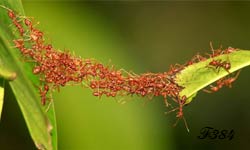
Living bridge of ants.
- When army ants move their nest, the soldiers form a hedge to protect the convoy of workers.
- To survive floods, Amazonian fire ants have developed the ability to form living rafts on the water.
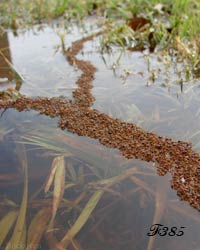
Floating walkway.
Evolution has even endowed them with an organ that meets an altruistic requirement, known as the social crop. This allows them to put some of the food they ingest into a secondary stomach, which is only used to feed members of the community who need it. The stimulus that leads to this mode of food transfer (trophallaxis) can be seen as an outline of empathy.
Although it would be excessive to speak of compassion for others in the case of ants, it is clear that at this early stage in the evolution of community life, ants already have the tools to help their fellow creatures and the natural impetus, sometimes lacking in humans, to use them.
Management of diseases and epidemics :
The organisation of work is done in cooperation, which is not the only element that brings ants closer to humans : they are also masters in epidemic management and could even serve as an example for us.
In a colony of ants, only 10% leave the nest in search of food for the whole community. They are therefore the ones who will come into contact with pathogens and infect the colony.
Also, when one of them gets sick, it tends to isolate itself and not move from room to room. At the same time, healthy ants tend to move away from sick individuals and protect the larvae and queen by burying them deeper in the nest, as Audrey Dussutour (researcher at the National Centre for Scientific Research in Toulouse, specialising in ants and single-cell organisms) explains.
1 VIDEO MP4 centrée :
Construction of an ant farm.
When disease is likely to spread, sick ants may even leave the colony if they feel they are going to die. The individuals will then form small groups that are connected to each other, but more distant from each other, a bit like families that gather together while avoiding contact with the whole society.
1 VIDEO MP4 centrée :
Care for the wounded.
In ants, the link that unites them is not through nervous connections, but through permanent emissions of pheromones. Although each ant can act individually, they are all connected by this link, which creates a kind of collective consciousness. The anthill thus resembles, according to the description given by the French writer Bernard Werber, "an organism whose cells are not united in a bag as we are in our skin, but remain welded together by communication".
It is therefore thanks to an intelligence based on cooperation and empathy that these societies made up of thousands of individuals can live and work in perfect harmony.
Flies :
In flies, is the flight response to danger just a reflex, or could it be considered the result of a fear emotion ?
Although insects such as bumblebees, bees and ants have the means to behave socially in a cooperative and helpful manner, science still cannot determine whether they experience the emotions that underlie our moral sense as we have seen in children.
So, while we don't know whether insects are capable of experiencing emotions, researchers at the University of Pasadena (USA) have been able to determine that flies show all the signs of fear, which would indicate a primitive emotion that causes them to flee.
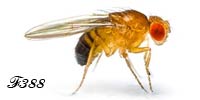
To arrive at this answer, William T. Gibson's team looked for traces of primitive emotions in Drosophila, and in particular :
- evolvability : when faced with danger, the animal's response is gradual and increases with the number of elements perceived as threatening,
- valence : which is the negative or positive impact of the emotion on the organism,
- and persistence : the presence of traces of emotion after the alert has passed.
To do this, 10 drosophila were subjected to the threat of a shadow flying over them. This shadow passed over more or less often and at intervals determined by the researchers.
By recording the reactions of the flies, either individually or in groups, to the passing shadow, the researchers were able to determine that primitive emotions are indeed present.
In another experiment, the researchers offered food to flies that had been fasting for 24 to 60 hours, again subjecting them to the threat of the shadow. They found that the need to feed competes with the need to flee.
Without equating the flies' behaviour with fear or anxiety, the researchers were able to deduce that they do respond to danger with emotional reactions.
While such results obtained with insects possessing so few neurons may come as a surprise, the challenge for science today is to understand which minimal circuit of neurons underlies a given cognitive capacity. But is the neuron essential for intelligence? Does intelligence depend on the neuron or on the single cell? In which case the only difference between the two would be the acquisition of appendages (axons, dendrites) facilitating the transmission of information, just as man has developed telephone networks to organise collective behaviour without delay.
How, then, do associations of cells organise themselves, which, although they have constructed buildings [in french] that are beyond comprehension, have not yet acquired specialists in remote communication ?
d - Plants and symbiosis :
For decades, and inspired by Darwin's vision ("Everywhere, the whole of nature is at war, each organism with another, or with nature outside"), all the disciplines of the life sciences only took into account the competition between species : the lion eats the gazelle, the bacterium feasts on an organism. By fighting for a place in the sun, the plant has not escaped this vision.
Today, with the new means at its disposal, science is changing its view of the world: while it has not forgotten competition, it is now focusing on cooperation.
Whatever form of life is observed, starting with human societies, cooperation and competition, compassion and savagery go hand in hand. The animal biology we are discovering today reveals as much mutual aid as selfishness, as many alliances as conflicts.
And cooperation within the same species is not unique to vertebrates with highly developed brains, or even to insects !
Canadian Suzanne Simard has discovered that old trees make important transfers of nutrients to their offspring growing at their foot. This allows the young to develop normally despite the absence of sunlight under the branches. These behaviours, which were thought to be reserved for animal species, were selected and conserved by evolution well before the appearance of these species: they are indeed the most likely to ensure their survival.
e – Bacteria :
New cooperative phenomena are also constantly being discovered in bacteria. For example, they perceive the size of their community, which enables them to adapt their behaviour: this ranges from reproduction to the emission of warning signals to their surroundings, or defence molecules.
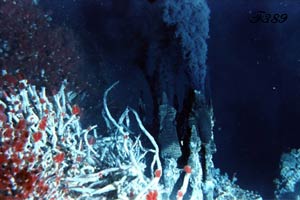
Ver riftia near a hydrothermal spring.
In the most hostile environments, the simplest organisms are now revealing this mutual aid for survival : it was with the discovery of hydrothermal springs in the 1980s that a real awareness of this phenomenon began. These hostile environments, sometimes located thousands of metres below the ocean surface, harbour surprising survival mechanisms.
In these places of crushing pressure, extreme temperature and acidity, where darkness prohibits photosynthesis, the only energy available is in chemical compounds such as sulphur: only a few species of bacteria are able to extract it.
A multitude of organisms (molluscs, crabs, worms, etc.) have therefore incorporated these bacteria, even going so far as to create organs to house them.
The best symbiosis is achieved by the Riftia worm, which can reach 2 m in length !
A new question then arises: did the organisms integrate foreign bacteria, or did these bacteria, after having adapted to the environmental conditions and created colonies, create new organisms before specialising in them ?
C – Relationships between different species :
Thus, after being interested in social behaviour between individuals of the same species, evolutionists have turned their attention to the relationships between different species.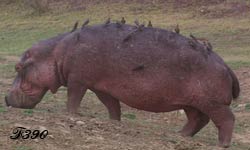 |
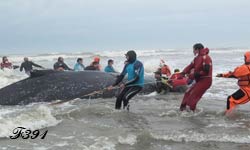 |
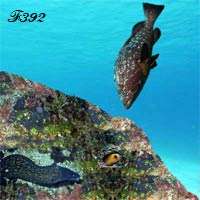
Cooperation between species.
Today, specialists are interested in the relationships between single-celled and complex organisms.
Symbiosis, as we have just seen, is a relationship in which both cell and organism are winners, and in which the notion of exploitation of the other is non-existent. Could we say that at this stage of evolution, this notion has not yet been invented ?
Symbiosis is thus found at all levels of the living world, and we ourselves are no exception to this alliance with the bacteria and viruses of our intestinal flora. As early as the 1970s, the American biologist Lynn Margulis taught us that it is found at the very heart of our cells: all animal cells house small 'energy centres', the mitochondria, which were originally symbiotic bacteria. In plants, the mitochondria that enable photosynthesis have a similar origin.
Thus, from the earliest stages of evolution, there appears what could be the first characteristic of the moral sense : cooperation.
This cooperation begins with associations within colonies of cells. It will be perfected in organisms where specialised cells cooperate.
 |
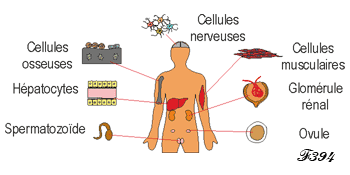 |
Volvox aureus in a colony. |
Specialised cells in an organism. |
If we then examine living beings, it seems that they all behave like researchers, constantly seeking answers to changes in their living conditions... unless chance alone guides these transformations ? If this were the case, man would not escape this same chance : would he not then lose the free will that he holds so dear ?
Do we know enough about the particles involved in this 'strange' matter to determine whether their assembly is the result of chance or of an internal 'intelligence' ?
While remaining on a question, could we then consider that oxygen and carbon molecules that associate for a better balance within the atmosphere or in the cells of an organism, "collaborate" with each other and with the other compounds ?
It would be premature to continue in this direction today. So, to return to the moral sense that remains our current subject of reflection, let us simply consider that :
« The moral sense of the animal differs from that of the child
only because its characteristics are incomplete,
because they are acquired gradually through evolution. »
only because its characteristics are incomplete,
because they are acquired gradually through evolution. »
D – From the living world to the world of matter :
All these interrelationships concern all the species that have appeared in the course of evolution, but also all the particles that have interacted since the birth of the universe. They have progressively assembled to form the first elements of organic matter : mitochondrial RNA, then viral and cellular DNA.Since life has matter as its support, could these interrelationships mean that the intelligence of living beings is a characteristic of matter itself ?
Even if we cannot speak of a moral sense at the most primitive stages of evolution, let us observe what is happening within DNA. Atoms and molecules have joined together in a long chain of genes. This chain is in constant interaction with its environment, and is constantly changing as the environment changes.
Some genes can even change their location within the chain, and the whole chain can be temporarily transformed during cell division.


DNA transformations during meiosis.
Each molecule is shown to be capable of 'cooperating' with an infinite number of others within the cells to respond to information from the environment and maintain 'Life'.
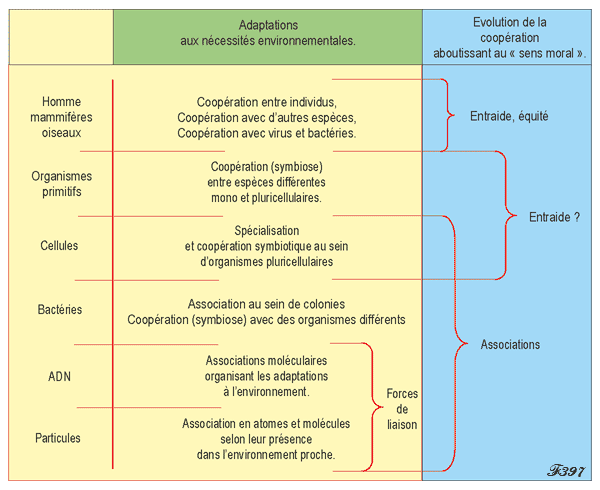
Forces, associations, cooperation, so many different languages
that describe how matter communicates.
that describe how matter communicates.
Thus, in the course of evolution, only the means used for "cooperation" between variable elements have changed : binding forces at the level of matter, chemical communication between cells, scent marks between insects, sign language, sound language, mathematical language....
In humans, consisting of some 30,000 billion cells, an equivalent number of bacteria and viruses constitute a microbiota without which no individual could survive.
In the living world, we have seen the means of communication between species, which enable them to adapt their behaviour.
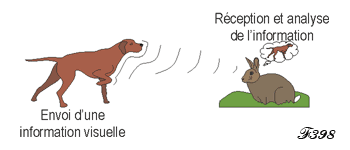 |
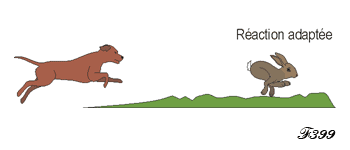 |
Information from the living world.
The world of matter also participates in exchanges. By stimulating the cellular or body envelopes, photons and sound waves "inform" the visual or auditory cells.
This is how matter reveals itself as the coordinator, at all stages of evolution, of the transformations that occur within the living world : is it not an integral part of Life ?
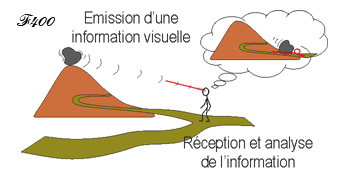 |
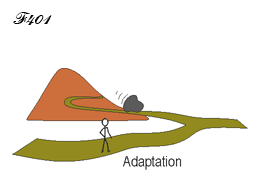 |
Information from the mineral world (light waves).
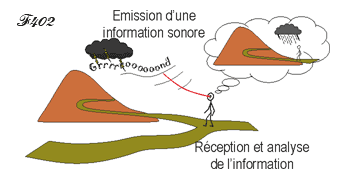 |
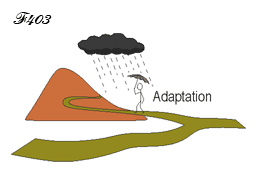 |
Information received via sound waves.
« Cooperation, a component of the moral sense,
is present, under different names, at all stages of the evolution of living beings.
Could the association of particles, also present at all stages of evolution,
represent the primordial form of this cooperation ? »
is present, under different names, at all stages of the evolution of living beings.
Could the association of particles, also present at all stages of evolution,
represent the primordial form of this cooperation ? »
Today, other means of communication are emerging, thanks to the development of mathematical language : after having invented machine language, which allows computer processors to communicate with each other, and man to communicate from any point on Earth, the human biological structure is in the process of providing robots, non-biological matter, with all the means to access intelligence by communicating with each other in order to evolve autonomously.
Could the quantum revolution that seems to be in the offing lead to the appearance of a new kingdom, that of living matter ?
« Can we separate the mechanisms of life
from those that govern interactions within matter ? »
from those that govern interactions within matter ? »
E – From animals to humans - How did humans become moral ?
a – Individual and collective well-being :Although animals often behave in ways that are close to human moral behaviour, we cannot yet be certain that they have a moral sense. It is therefore human moral behaviour that we can try to understand in order to determine its causes. Many of these behaviours can be explained by secondary benefits, but this is not always the case.
For example, jumping into the water to save an individual goes against the instinct of self-preservation. For this reason, this type of behaviour puzzles specialists because evolution generally selects for acts that bring benefits in terms of survival or reproduction.
Yet this cost is only apparent. These astonishing behaviours often provide hidden benefits, and when these benefits outweigh the costs, the paradox disappears : It can be, for example, social or even historical recognition, or access to Paradise, i.e. divine recognition, even at the price of martyrdom.
The association for simple survival has thus been perfected in higher species : by integrating the influence of molecules and nerve centres that generate well-being or malaise, behaviours have been reinforced and stabilised.
Thus, jumping into the water to try to save someone is certainly costly in terms of effort and risk of death, but the feeling of empathy that drives this act is immediately justified by the relief of negative emotions that accompanied the spectacle.
However, in general, the self-preservation instinct will be favoured, as it is a source of well-being independent of the social context.
Later, personal well-being and discomfort were supplemented by the notions of good and evil, which then concerned human societies : the collective "good" could paradoxically be the source of personal discomfort.
b - The origins of human morality - Evolutionary theories :
If individual well-being favours the relationships that give rise to it, several theories propose other explanations for the appearance of collective morality.
1 - The perpetuation of the species :
For Patricia Churchland, an evolutionary philosopher, all altruistic activity originates in motherhood : indeed, oxytocin, an essential hormone of this period, gives rise to the behaviours (benevolence, trust, cooperation) that will serve as a model for all other pro-social behaviours. It would therefore be from purely biological predispositions that the moral behaviour of animal and human societies would have developed.
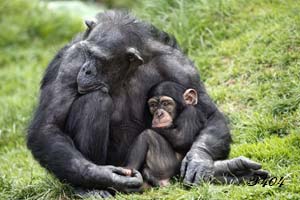
However, if cooperation and equity facilitate and harmonise relations between individuals, we can no longer speak of a moral sense when it comes to nepotism. A true moral sense would require fairness for all.
2 - Competition between groups :
Another evolutionary theory suggests that the costs of moral behaviour would be offset by the benefits of intergroup competition. Indeed, this competition would have benefited the most altruistic groups because they were the most competitive. In the long run, only those groups made up of moral elements (i.e. favouring cooperation) would have survived, perpetuating the moral behaviour.
However, if morality only benefited the group, individuals would have a utilitarian morality, favouring the group and neglecting the individual and his well-being.
This theory, based on moral calculation, makes sense of pushing a person under a train to save five because this behaviour favours the group by saving the most lives.
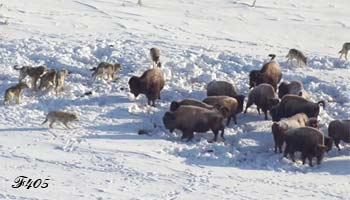
A third theory suggests that the costs of moral behaviour would be compensated by the social benefits derived by the person who took the risk.
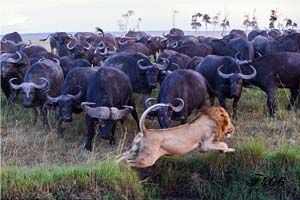
Although most theories have their limits, it is the pro-social predispositions (empathy, altruism and trust) common to both higher primates and humans that are at the origin of moral behaviour.
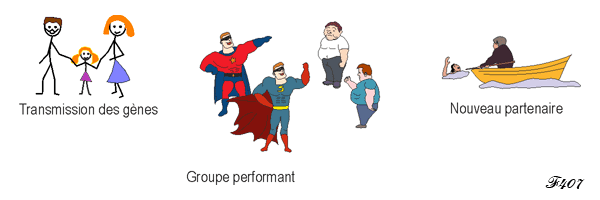
The 3 evolutionary theories.
- Kinship instinct (couple) : transmission of its genes.
- Benefits for the group (group) : it becomes more efficient than other groups.
- Social benefits (help) : access to new partners improving survival.
- Kinship instinct (couple) : transmission of its genes.
- Benefits for the group (group) : it becomes more efficient than other groups.
- Social benefits (help) : access to new partners improving survival.
b - Is morality unique to humans ?
Evolution allows us to understand the reasons that have fixed moral behaviour in the genetic heritage that has come down to us. But do these behaviours exist only within the human species ?
If, up to now, behaviours described as 'moral' could be linked to an egoism in which the calculation of benefits escaped our consciousness, what can we say about dolphins that have saved swimmers from drowning, or predators that can spare the young of another species ?
However, helping those who have the least, as abbé Pierre did in France, or fighting against slavery, as the Catalan Jesuit Pierre Claver (1580-1664) did, are all moral behaviours that are difficult to find in other animals.
On the other hand, the precision of human moral judgements does not exist in any other species, nor does the diffusion of good deeds which favours altruism.
In the current state of knowledge, the scientific community agrees that human morality is far superior to that of other species.
But is human morality really superior or just different from that of other species because it is adapted to a different context ?
For example, unlike humans, animals do not take more than they need to live, and while they too kill for food or self-defence, they rarely slaughter unnecessarily.
If human morality is characterised by its organisation, this organisation was achieved through the acquisition of language, and it is still through language that researchers have been able to determine the characteristics of the individual's moral sense.
So, would it not rather be the child's innate moral sense, capable of adapting to the diverse and often contradictory needs of human societies, that deserves attention ? And would it not be this sense that most closely resembles that of animals ?
« More than the moral sense, which translates into behaviour that respects life
and belongs to the living world in general,
it is the rational organisation of this sense that has developed in the human adult. »
and belongs to the living world in general,
it is the rational organisation of this sense that has developed in the human adult. »
So how does human morality differ from the 'moral' sensibility of the animal world ?
To answer this question, we could distinguish here two complementary forms of morality :
- a rational morality which, by protecting society, can oppose individual needs.
- an emotional morality that seeks personal well-being in communion with the well-being of the other.
« If rational morality is based on an egoism that tends to the betterment of society through the search for social benefits,
the emotional moral sense is based on an egoism that seeks individual well-being.
- The former attempts to respect individual well-being while adapting it to the needs of the community,
- The second may require killing to survive,
but it can also be in communion with the well-being of the other,
and be called love. »
the emotional moral sense is based on an egoism that seeks individual well-being.
- The former attempts to respect individual well-being while adapting it to the needs of the community,
- The second may require killing to survive,
but it can also be in communion with the well-being of the other,
and be called love. »
Next chapter :
3 – Ethics and Religions : (continued)

